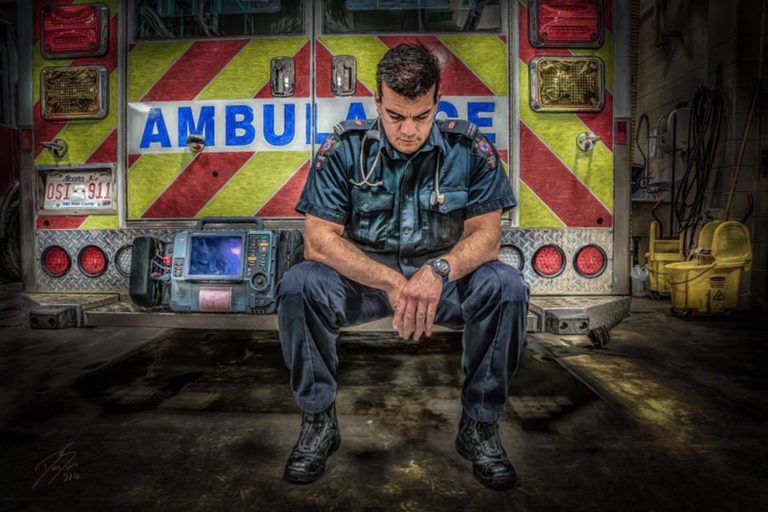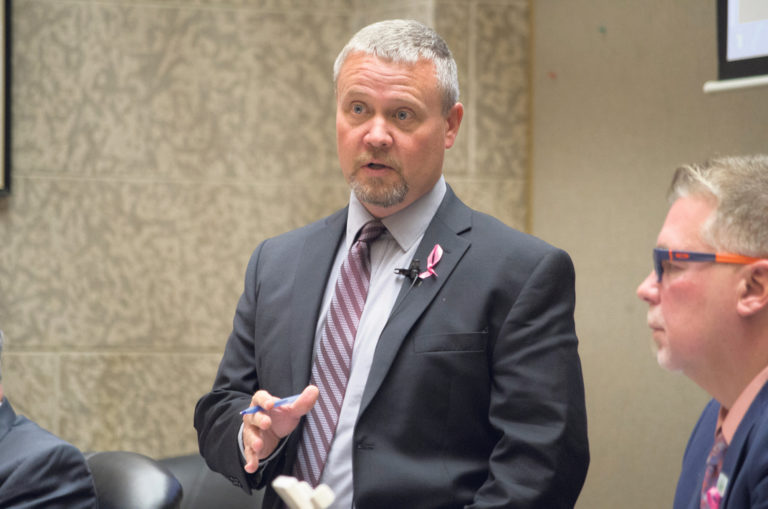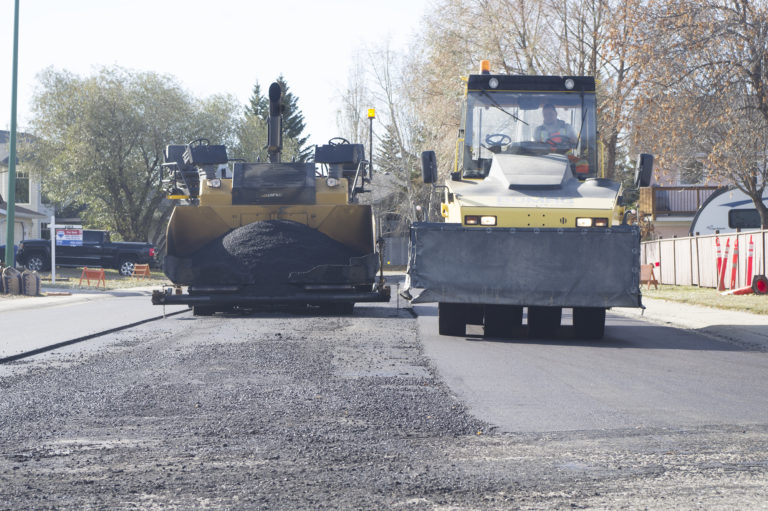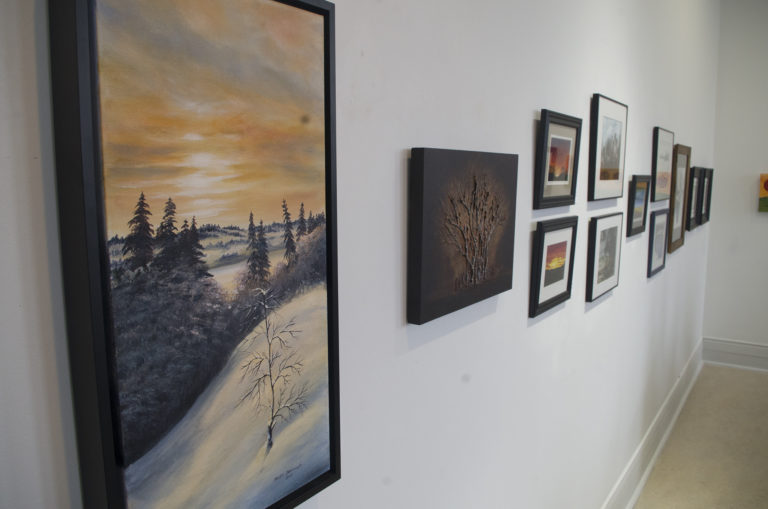Editor’s note: part one of this story appeared in the Oct. 23 edition of the Prince Albert Daily Herald. Part two appeared on Oct. 24.
In 1979, Brian Willis was a fresh-faced rookie officer with the Calgary Police Service.
Peter Lougheed was the province’s premier. The NHL’s Flames were still in Atlanta. The Calgary Tower was still the city’s tallest structure, and almost nobody on the police force talked about mental health. It was a different time.
“There was still, I think, a stigma attached to going and asking for help,” Willis remembered. “A lot of times back then the help was just getting together with a group of people over beers—which isn’t necessarily helpful—and ruminate about the challenges you are facing. But, nobody really wanted to talk.”
As a member of a large police force in a major city, Willis had access to treatment other officers didn’t. Calgary’s police department had a full-time police psychologist to help officers work through any issues. Unfortunately, Willis said, it was rare for someone to admit taking up the offer.
Today some things are different. Governments have come and gone. The Flames gave Calgary a Stanley Cup. The Suncor Energy Centre became the tallest building, and mental health services have become more and more available both in Calgary and around the country. Unfortunately, one thing that hasn’t changed is the stigma.
“A lot of us were ingrained with the mentality that big girls and big boys don’t cry. You suck it up and soldier on,” Willis explained. “If you need help, then you’re (seen as) weak, and if you’re weak, then get out. I think there’s still a lot of that historic misperception and weakness attached to asking for help.”
Willis retired from the police service in 2004. These days he travels North America helping to train law enforcement officers as president and CEO of Winning Mind Training. The task took him to Prince Albert this past weekend for the third annual PTSD-OSI Awareness Conference, where he was one of several guests speaking to emergency service workers from around the area.
Despite the stigma, Willis is optimistic about the future, largely because of conferences like this one. Significant strides in available resources and public perception have helped drive the issue to the forefront. His goal is to get emergency workers and the general public to toe a very fine line. On one side, is the idea that working in emergency services means you automatically experience loads of trauma, which Willis said simply isn’t true. On the other side is the idea that the trauma barely exists at all. He’s hopeful that if the next generation can learn to walk that line early in their careers, they can avert a lot of problems.
“The men and women in emergency services are human,” he explained. “Sometimes they’re asked to perform at superhuman levels, but they’re human beings. When they need help, it doesn’t mean they’re not fit for the job. It just means that they need some help to deal with some of those issues on a day-to-day basis. That support from the public as well as the support inside is critical.”
Out of the city and into the country
Willis considers himself fortunate for starting his career in a big city that had some resources available for officers suffering from PTSD (Post-Traumatic Stress Disorder) or OSI (Occupational Stress Injury). However, those in the rural parts of the country weren’t so lucky.
Wayne Jasper spent 30 years as a firefighter in Victoria, but he retired to a small community in the Okanagan where he currently serves as a training officer and assistant fire chief. Even though rural firefighters might not respond to as many events as their metropolitan counterparts, the individual calls can be just as hard, or harder.
“There’s a good chance that when you’re going to an emergency response in a smaller community, you know somebody you’re responding to,” Jasper explained. “It can almost increase their chances of having a traumatic exposure over somebody in a large metropolitan area.”
Jasper started his career in a volunteer fire department and he’s going to end it that way. He’ll soon start his 35th year of service, and looking back on it, he said it’s obvious some of his colleagues were looking for help.
“When you look back today in retrospect as to what it was, it makes sense,” he said. “Back then it didn’t because we had no education on PTSD, what it was or what it did to you. Things weren’t really attributed to that.”
Like Willis, Jasper travels the country giving presentations and talking to emergency service personnel about their experiences and on Sunday that stop came in Prince Albert. During that time he’s started to see some improvements. For example, fire departments are starting to track the number of traumatic calls a member responds to in the same way they track exposure to smoke, asbestos or other hazardous material. It’s an important step in treating traumatic events like other workplace injuries.
Jasper said those changes will help, but if it has to be accompanied by a more respectful view of mental illness. If not, the changes won’t be much help to firefighters, whether they answer calls at busy intersections and apartment buildings, or dirt roads and farmyards. Awareness is already increasing, he explained. Now it’s just a matter of turning that awareness into action.
“We all hope for the best that it’s going to change, and it is changing,” he said. “I won’t say there it’s not changing. It is gradually changing. People are talking about it more.”
A new start
Jasper’s talks aren’t identical, but one common theme is how the language surrounding PTSD and OSI has changed. Gone are the days when doctors would talk about shell shock or operational exhaustion. Instead, it’s PTSD, although OSI is becoming more and more common. Jasper stresses that it’s difficult to understand mental health concerns without having the right vocabulary to talk about it.
That’s something Chris Siddons can relate to. Siddons has spent the last two years working in emergency services, but before that, he served 10 years in the British Army. When he was discharged in 1996 he was suffering from major PTSD and depression. Worse, he didn’t even know until he came to Saskatchewan.
“I walked into emerge (the hospital emergency room) in Regina and said, ‘there’s something wrong with me,’” Siddons remembered. “I didn’t know it was PTSD or OSI. I had all the symptoms and the traits and the signs, but I didn’t know what it was. I walked into emerge and I saw the on-call psychiatrist and I was diagnosed and admitted as an inpatient within an hour and a half—diagnosed with major depression and PTSD from my military service. That’s me finding out about PTSD in 2014.”
After his diagnosis, Siddons began looking for support groups, mental health programs, or anything else that could help his recovery. He found very little. Instead, he saw people who were scared to come forward and talk about something they didn’t understand. Although discouraging at the time, Siddons took the opportunity to create a group of his own called OSICAN. Today, the group has chapters all over Saskatchewan, including Prince Albert.
Siddons said those groups, and conferences like this one in Prince Albert, have given people confidence. Changes to the Workers Compensation Board in 2015 have also made it easier for those suffering from traumatic experiences to seek help. In just four years, he’s seeing positive change.
“The stigma is definitely fading away now,” he explained. “It’s more of a topic in the workplace, so both employees and employers are not afraid to talk about it. Within emergency services, people are not afraid to come forward now and say, ‘I may have an issue. Can I go see somebody?’”
The path to healing
With awareness on the rise and many emergency service personnel opening up for the first time, the focus is shifting from talk to treatment.
Daniel Sundahl, a 15-year paramedic and firefighter from Edmonton, found himself in a similar situation as Siddons. Like the OSICAN founder, Sundahl was suffering from PTSD, and like Siddons, he too didn’t totally realize what was happening.
“In emergency services, a lot of people probably don’t know, it’s a brotherhood and a sisterhood,” Sundahl said. “You rely a lot on each other, so it’s really difficult to say something or to admit to your brothers and sisters that you’re mentally broken or you have a mental injury, because you don’t want to admit that you’re unable to do the job. There’s a lot of shame and embarrassment.”
Like Siddons, Sundahl wasn’t content to sit back and leave things the way they were either. It’s one thing to talk, he explained. It’s another to “put your money where your mouth is.” After being diagnosed, he started to do just that. Today, Sundahl’s biggest passion is his artwork, which is proudly displayed on his website and Facebook page. His photo-art exhibits draw on his past experiences in emergency services. His paintings display firefighters, police officers and paramedics grappling with the difficulties caused by their work. Not every painting is easy, but they give Sundahl a therapeutic outlet, and a way to help his colleagues.
“My artwork is all very personal to me,” he said during a short break in the conference schedule. “But, I feel if I can speak up and say this is what happened to me, but I got treatment and I’m better and in fact, I’m thriving and I’m better than I was before, then I’m hoping that other people will think it’s okay to speak up too.”
Helping others deal with their traumatic experiences is a family concern. Sundahl speaks to conference attendees in the afternoon about painting and how it helped him overcome his own challenges. However, the sun has barely risen when his wife Roxanne leads an early morning therapeutic yoga session at the Prince Albert Golf and Curling Club.
Roxanne has been teaching it since 2013. When Daniel started his own therapy, she decided to help out the best way she could.
“It’s a way of calming down your heart and those emotions that can fly crazy,” she said shortly after her session ended. “It’s a start to reconnecting with yourself.”
Life hasn’t been easy for the couple. When Daniel was diagnosed, it put a significant strain on their marriage. Yoga became a way for Roxanne to help her husband with his own pain, while also taking care of herself. Eventually, she became a certified yoga teacher for stress and trauma.
“It worked so much for me, to help me as a way through. I just wanted to help others,” she said.
On the ground in Prince Albert
The drive to get people talking about OSI in Prince Albert had a slow start. When it began in January 2016, the founders required financial support from an anonymous donor just to keep the doors open. The attendance fees from this year’s conference will help fund OSI groups like the one in Prince Albert, so money isn’t as crucial an issue. Instead, they can put the focus where it needs to be — on healing emergency services personnel.
“It’s about finding solutions now,” said Michelle McKeaveney, one of the local chapters’ original founders. “We’ve created awareness. We’ve told everyone they have PTSD, so now they’re saying, ‘what do we do? How do we work towards more solutions?’”
McKeaveney said the key is to get young paramedics, firefighters, police officers and corrections workers to start taking care of themselves early in their careers. Good habits, and an improved climate in which to talk about any traumatic incidents, will help avert a lot of pain down the road.
In a few short years, McKeaveney is starting to see change, both in the group and at the conference.
“I see a lot of recovery and resiliency,” she explained. “The people who maybe didn’t do so well after the first conference are here two years later to gain new strength and new skills to better themselves, and that’s what it’s about.”
The Prince Albert OSI-CAN group didn’t just grow in numbers, although it did that too. At the start, it was a few members meeting in a small room at the back of a local church. Now, they’ve grown enough to help start a second chapter in Tisdale.
McKeaveney has even started work on her dream project—trying to get a special home built in a rural area near Prince Albert where stressed emergency service workers can go for healing and relaxation. There’s still a long road ahead, but she’s confident the group and the conference are on the right path.
“We are blessed as an organization,” she said. “This little prairie Saskatchewan isolated initiative, with no federal funding or provincial funding started on a donation, has expanded in three years of creating some really great things.”
To learn more about OSICAN, visit www.osican.ca. The website includes contact information for every OSI group in Saskatchewan.
@kerr_jas • jason.kerr@paherald.sk.ca










